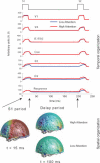Using large-scale neural models to interpret connectivity measures of cortico-cortical dynamics at millisecond temporal resolution
- PMID: 22291621
- PMCID: PMC3258667
- DOI: 10.3389/fnsys.2011.00102
Using large-scale neural models to interpret connectivity measures of cortico-cortical dynamics at millisecond temporal resolution
Abstract
Over the last two decades numerous functional imaging studies have shown that higher order cognitive functions are crucially dependent on the formation of distributed, large-scale neuronal assemblies (neurocognitive networks), often for very short durations. This has fueled the development of a vast number of functional connectivity measures that attempt to capture the spatiotemporal evolution of neurocognitive networks. Unfortunately, interpreting the neural basis of goal directed behavior using connectivity measures on neuroimaging data are highly dependent on the assumptions underlying the development of the measure, the nature of the task, and the modality of the neuroimaging technique that was used. This paper has two main purposes. The first is to provide an overview of some of the different measures of functional/effective connectivity that deal with high temporal resolution neuroimaging data. We will include some results that come from a recent approach that we have developed to identify the formation and extinction of task-specific, large-scale neuronal assemblies from electrophysiological recordings at a ms-by-ms temporal resolution. The second purpose of this paper is to indicate how to partially validate the interpretations drawn from this (or any other) connectivity technique by using simulated data from large-scale, neurobiologically realistic models. Specifically, we applied our recently developed method to realistic simulations of MEG data during a delayed match-to-sample (DMS) task condition and a passive viewing of stimuli condition using a large-scale neural model of the ventral visual processing pathway. Simulated MEG data using simple head models were generated from sources placed in V1, V4, IT, and prefrontal cortex (PFC) for the passive viewing condition. The results show how closely the conclusions obtained from the functional connectivity method match with what actually occurred at the neuronal network level.
Keywords: EEG; MEG; decoding; delayed match-to-sample (DMS); high resolution; information processing; large-scale networks; timing.
Figures



References
-
- Amari S. (1977). Dynamics of pattern formation in lateral-inhibition type neural fields. Biol. Cybern. 27, 77–87 - PubMed
-
- Arnhold J., Grassberger P., Lehnertz K., Elger C. E. (1999). A robust method for detecting interdependences: application to intracranially recorded EEG. Physica. D 134, 419–430
-
- Atkinson R. C., Shiffrin R. M. (1968). Human Memory: A Proposed System and Its Control Processes. New York: Academic Press
LinkOut - more resources
Full Text Sources
Miscellaneous

